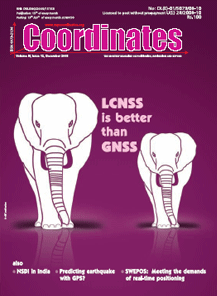
Current global navigation satellite systems (GNSSs) [1] are based on signals lying within the L-band of the radio-navigation satellite service (RNSS) spectrum. Since the need for more systems and signals is emerging, new alternative frequency resources are needed. In particular, the C-band frequency portion is envisioned as an option for future GNSSs…

Associate members representing key GNSS user communities – including the US, Russia, European Union, China, India, and Japan – met at the 3rd meeting of the International Committee on GNSS (ICG-3), a voluntary UN backed association that brings together GNSS and augmentation providers. An appeal for collaborative efforts that would move beyond interoperability to “interchangeability” was made.

U-blox supplying GPSS for Longcheer chinese handsets
Chinese mobile phone designer Longcheer Holdings Ltd will integrate Swiss chip maker u-blox’ single chip UBX-G5010 GPS receiver into a series of handsets. The models built incorporating the device, the G600, G800, and G630 have just become available while the G801 and G900 are expected to begin shipments to the Chinese market later in this quarter. www.u-blox.com

Dr R Siva Kumar CEO National Spatial Data Infrastructure on status and directions of NSDI in India
We are not hearing much about NSDI? What is the status of NSDI?
The vision behind NSDI is to make data available and accessible. Keeping this objective in mind policies and framework are formulated. Various aspects of …

The competition started nearly two decades ago in the United States as the National Engineers Week Future City Competition with the aim to provide fun and exciting educational engineering programs for school students by combining stimulating engineering challenges with ‘hand-on’ application to enable them to present their vision of a city of the future…

EU developing ‘militarised’ space policy which could trigger ‘arms race’
The European Space Agency is accused of developing technology to dominate the “high ground” of space, including a multimillion pound EU Satellite Centre in Spain. The Transnational Institute, a Dutch think-tank, said: “EU-financed communication and spy satellites are slowly becoming reality and in the long term the inclusion of space-based missile defence and other more offensive uses of space are real options for an increasingly ambitious EU military space policy.” The report said French ambitions for the “militarisation of space” have led to arguments with Britain – particularly over Galileo, the much-delayed European global positioning system. President Nicolas Sarkozy of France, who currently holds the Presidency, said in June that space agenda was one of his priorities. Galileo would be vital in any European deployment of the sort of GPS-guided artillery now being used by the US in Iraq and Afghanistan














 (5.00 out of 5)
(5.00 out of 5)